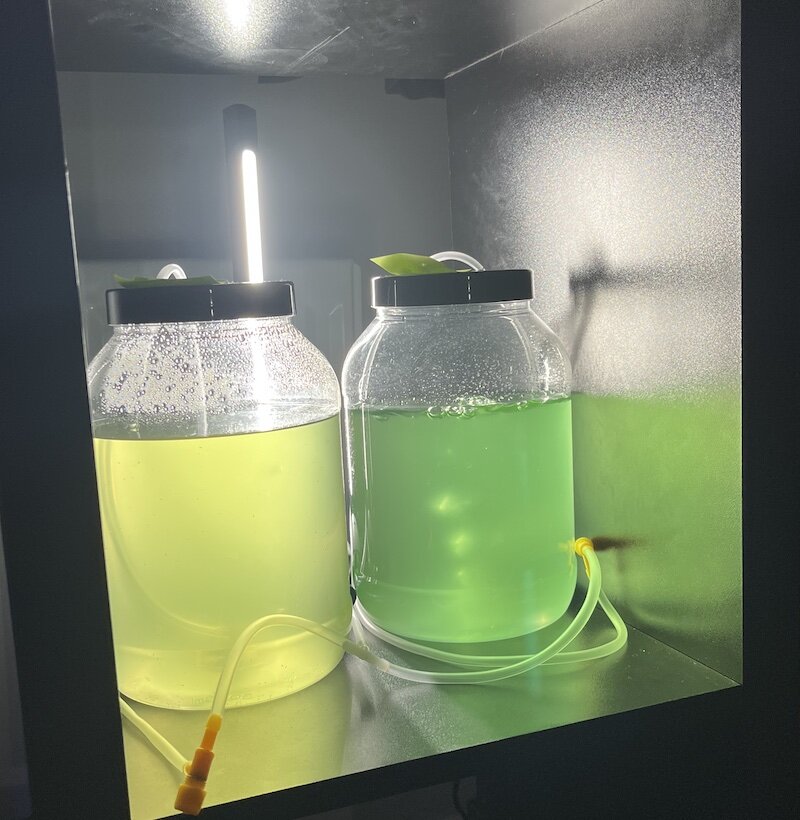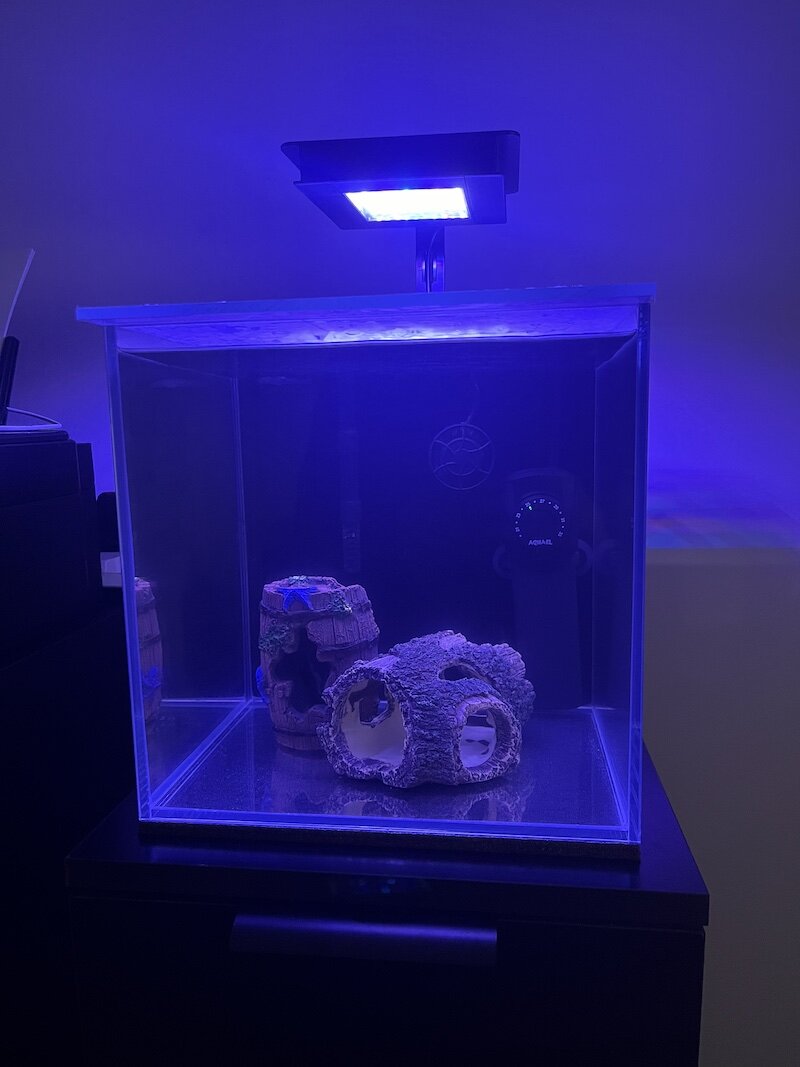You mean you would take sand from a beach, even if there's a chance it's polluted?Hi all,
I honestly wouldn't worry. You would only need a small inoculum of slightly muddy sand.
cheers Darrel
-
You are viewing the forum as a Guest, please login (you can use your Facebook, Twitter, Google or Microsoft account to login) or register using this link: Log in or Sign Up
You are using an out of date browser. It may not display this or other websites correctly.
You should upgrade or use an alternative browser.
You should upgrade or use an alternative browser.
Journal Oase Scaperline 60 Reef Tank
- Thread starter Tanksy
- Start date
Do you quarantine your corals before adding them to the DT?Yes sadly that’s the best we can do without access to proper live rock. I always try and find the biggest colonies of zoas and mushrooms in my LFS as they tend to come on rock. This helps import that micro fauna and bacteria we need.
I also do not dip corals (this obviously can have its cons).
Hi all,
I'm <"not a microbiologist"> but my understanding is that any sample from the natural environment will contain a huge range of microbes <"Bacteriological water analysis - Wikipedia">, many of which sound fairly scary on paper.
"Huge diversity" is the thing that interests me, it just makes it much more likely that you initial inoculum will have suitable microbes for your tank. We don't know what they are (and they may be scientifically undescribed, Archaea, rather than bacteria etc) but we don't need to know what they are, the tank is going to select the ones "it wants". <"Bacterial community analysis of marine recirculating aquaculture system bioreactors for complete nitrogen removal established from a commercial inoculum - PubMed">.
Have a look at <"Correspondence with Dr Ryan Newton - School of Freshwater Sciences, University of Wisconsin—Milwaukee">, they are looking at freshwater, but the same will apply to marine situations, it is just the initial inoculum needs to come from a beach etc for a marine tank.
Coliform bacteria are easy to culture, which means any tiny inoculum will rapidly cover an agar plate, but that isn't going to happen in your tank, conditions aren't suitable.
cheers Darrel
Yes, it will be polluted <"https://publications.parliament.uk/pa/cm199798/cmselect/cmenvtra/266ii/et0216.htm">, but it would be even if it came from a "pristine" environment.You mean you would take sand from a beach, even if there's a chance it's polluted?
I'm <"not a microbiologist"> but my understanding is that any sample from the natural environment will contain a huge range of microbes <"Bacteriological water analysis - Wikipedia">, many of which sound fairly scary on paper.
"Huge diversity" is the thing that interests me, it just makes it much more likely that you initial inoculum will have suitable microbes for your tank. We don't know what they are (and they may be scientifically undescribed, Archaea, rather than bacteria etc) but we don't need to know what they are, the tank is going to select the ones "it wants". <"Bacterial community analysis of marine recirculating aquaculture system bioreactors for complete nitrogen removal established from a commercial inoculum - PubMed">.
....... Bacteria having the capacity to carry out ammonia and nitrite oxidation were more abundant in the nitrification biofilter. Similarly, the proportion of the bacterial taxa known to carry out heterotrophic and autotrophic denitrification and participate in sulfur cycling were found in the denitrification bioreactor, and likely originated from the ambient environmental water source. Our results indicated that environmental seawater can be a favorable enhancement to the bacterial consortium of recirculating aquaculture systems biofilters........
Have a look at <"Correspondence with Dr Ryan Newton - School of Freshwater Sciences, University of Wisconsin—Milwaukee">, they are looking at freshwater, but the same will apply to marine situations, it is just the initial inoculum needs to come from a beach etc for a marine tank.
Coliform bacteria are easy to culture, which means any tiny inoculum will rapidly cover an agar plate, but that isn't going to happen in your tank, conditions aren't suitable.
cheers Darrel
Last edited:
seedoubleyou
Member
Nope never. The tank is small enough to spot and deal with any nasties (I’ve had none yet).Do you quarantine your corals before adding them to the DT?
For me, everything that enters the tank is part of the process, beneficial or not.
I’ve had no unpleasant experiences with this tank thus far and my approach was completely different to anything I’ve done before.
“Live sand” (AF bio Sand)
Carribsea life rock
Filled it up
Bottled bacteria and fish
Heavy coral stocking the next day.
I had diatoms from a week or so and just dealt with them chemically using GFO.
Hi all,
Yes, it will be polluted <"https://publications.parliament.uk/pa/cm199798/cmselect/cmenvtra/266ii/et0216.htm">, but it would be even if it came from a "pristine" environment.
I'm <"not a microbiologist"> but my understanding is that any sample from the natural environment will contain a huge range of microbes <"Bacteriological water analysis - Wikipedia">, many of which sound fairly scary on paper.
"Huge diversity" is the thing that interests me, it just makes it much more likely that you initial inoculum will have suitable microbes for your tank. We don't know what they are (and they may be scientifically undescribed, Archaea, rather than bacteria etc) but we don't need to know what they are, the tank is going to select the ones "it wants". <"Bacterial community analysis of marine recirculating aquaculture system bioreactors for complete nitrogen removal established from a commercial inoculum - PubMed">.
Have a look at <"Correspondence with Dr Ryan Newton - School of Freshwater Sciences, University of Wisconsin—Milwaukee">, they are looking at freshwater, but the same will apply to marine situations, it is just the initial inoculum needs to come from a beach etc for a marine tank.
Coliform bacteria are easy to culture, which means any tiny inoculum will rapidly cover an agar plate, but that isn't going to happen in your tank, conditions aren't suitable.
cheers Darrel
There's no pristine environment left. Scientists have found micro plastics everywhere. But the problem with untreated sewage dumped in the UK's rivers and sea is out of control lately.
Do I want another person's caca in my reef tank? No, thank you! 😅
Nope never. The tank is small enough to spot and deal with any nasties (I’ve had none yet).
For me, everything that enters the tank is part of the process, beneficial or not.
I’ve had no unpleasant experiences with this tank thus far and my approach was completely different to anything I’ve done before.
“Live sand” (AF bio Sand)
Carribsea life rock
Filled it up
Bottled bacteria and fish
Heavy coral stocking the next day.
I had diatoms from a week or so and just dealt with them chemically using GFO.
You're brave! I wouldn't want a pest i.e aptasia getting into my tank. I'd rather kill some bacteria than risk it.
seedoubleyou
Member
I’ve had one aiptasia get in on some zoas I bought. I just threw them out after they served the purpose of seeding the tank.aptasia
There are ways of combating aiptasia though. So a small outbreak wouldn’t have been an issue.
The way you’re going about setting up your tank is genuinely admirable, I wish I had the patience, hence going the way I did with a huge initial cost in coral stocking to help stabilise the tank. No different to setting up a planted system. Heavy on the stocking from day one.
Thanks mate! But it's just a different approach. Many hobbyists follow your method and have beautiful reef tanks. All roads lead to Rome.I’ve had one aiptasia get in on some zoas I bought. I just threw them out after they served the purpose of seeding the tank.
There are ways of combating aiptasia though. So a small outbreak wouldn’t have been an issue.
The way you’re going about setting up your tank is genuinely admirable, I wish I had the patience, hence going the way I did with a huge initial cost in coral stocking to help stabilise the tank. No different to setting up a planted system. Heavy on the stocking from day one.
After yesterday's 50% WC, ammonia dropped even more.
Salinity: 1.015 (Refractometer)
Temp: 27.5-27.8 C (Inkbird)
pH: 8 (Salifert)
NH3: 0.03 ppm (Seachem Ammonia Alert)
NO3: 25 ppm (Salifert)
I have only one wave maker, so today I ordered a second one, a Jebao ELW-3M. Supposed to be 4 x 4cm and move 900-2500 L. We'll see.
This is how it looks like at the moment. Took photo using a torch.
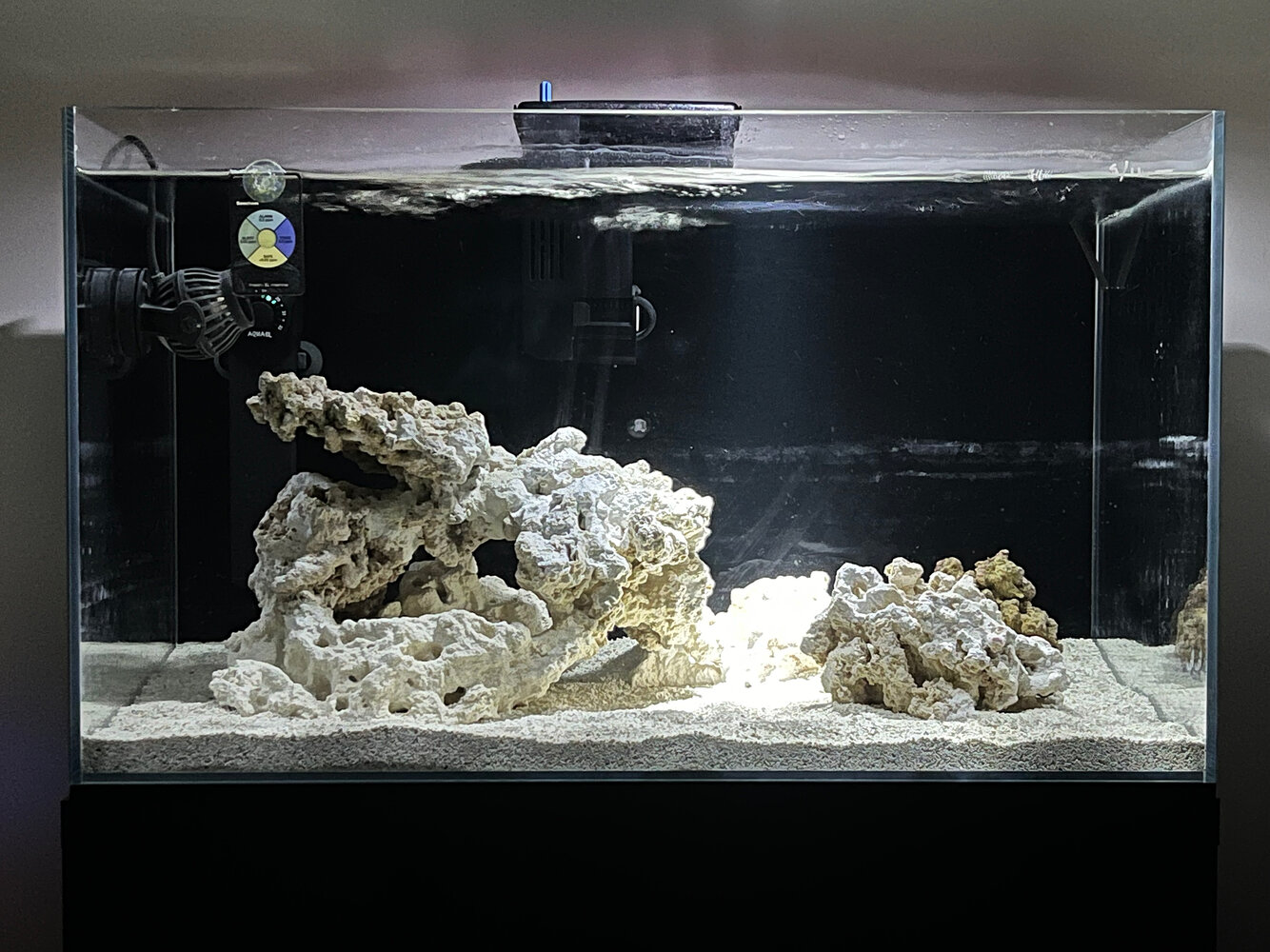
Salinity: 1.015 (Refractometer)
Temp: 27.5-27.8 C (Inkbird)
pH: 8 (Salifert)
NH3: 0.03 ppm (Seachem Ammonia Alert)
NO3: 25 ppm (Salifert)
I have only one wave maker, so today I ordered a second one, a Jebao ELW-3M. Supposed to be 4 x 4cm and move 900-2500 L. We'll see.
This is how it looks like at the moment. Took photo using a torch.

Last edited:
I've added 2 Mollies (one Black and one Silver, both males) yesterday evening, after a 4 hour drip acclimation.
Today was the first time feeding them. Dropped a pinch of Hikari pellets and they devoured them at once. That's a good sign.
Today was the first time feeding them. Dropped a pinch of Hikari pellets and they devoured them at once. That's a good sign.
seedoubleyou
Member
That’s a steep acclimation. Shows just how tough they are.I've added 2 Mollies (one Black and one Silver, both males) yesterday evening, after a 4 hour drip acclimation.
Today was the first time feeding them. Dropped a pinch of Hikari pellets and they devoured them at once. That's a good sign.
I've read that, back in the olden days, people used to dump them in straight away to cycle their tanks. Some still do, while others acclimate them for days.That’s a steep acclimation. Shows just how tough they are.
The worst thing when acclimating a fish is ammonia build up. So I always add Seachem Prime as soon as I open the bag from the shop, use an airstone and try to shorten the drip acclimation time as much as possible.
I've never lost a fish until now. However, I've never acclimated a FW/brackish fish to SW before. Hopefully they'll do fine, as they swim around and eat like pigs.
seedoubleyou
Member
When I kept freshwater tanks, I somehow ended up with an amano shrimp in my saltwater tank.
Every day it evaded my pufferfish and lived out it’s life.
Every day it evaded my pufferfish and lived out it’s life.
Did a 40% WC yesterday, mostly to increase the salinity. Switched from Instant Ocean to Tropic Marin Salt. Started dosing Microbacter7 and ordered copepods and phytoplankton.
Also, I removed the sides of the cardboard cover. Felt kind of bad keeping the fish in almost total darkness. Ambient light won't be an issue.
Latest readings:
Temp: 25 C
pH: 8 (Salifert)
Salinity: 1.020 SG (Refractometer)
Alkalinity: 7.1 dKH (Hanna)
Nitrate: 10 ppm (Salifert)
Phosphate: 0.08 ppm (Hanna)
Calcium: 350 ppm (Salifert)
All parameters look good, except Calcium, which makes sense, since the salinity is not as high as it's supposed to be.
This is the boring stage. I don't expect anything to change in the next couple of months.
Also, I removed the sides of the cardboard cover. Felt kind of bad keeping the fish in almost total darkness. Ambient light won't be an issue.
Latest readings:
Temp: 25 C
pH: 8 (Salifert)
Salinity: 1.020 SG (Refractometer)
Alkalinity: 7.1 dKH (Hanna)
Nitrate: 10 ppm (Salifert)
Phosphate: 0.08 ppm (Hanna)
Calcium: 350 ppm (Salifert)
All parameters look good, except Calcium, which makes sense, since the salinity is not as high as it's supposed to be.
This is the boring stage. I don't expect anything to change in the next couple of months.
Last edited:
Did an 80% WC last Sunday.
Latest readings:
Temp: 24.7 C
pH: 8 (Salifert)
Salinity: 1.025 SG (Refractometer)
Alkalinity: 8 dKH (Hanna)
Nitrate: 2.8 ppm (Hanna)
Phosphate: 0.1 ppm (Hanna)
Calcium: 375 ppm (Salifert)
The copepods and the phyto I ordered from an online shop never arrived. So I cancelled the order. I wonder how some businesses are still running.
Anyway, I received a new Hanna Calcium checker, an auto top up and a skimmer yesterday. Nothing fancy, a Kamoer ATO 2 and a Bubble Magus MiniQ. I installed the skimmer after a bath in citric acid.
The tank is quite new, so there's not much waste to skim.
Photo taken yesterday evening
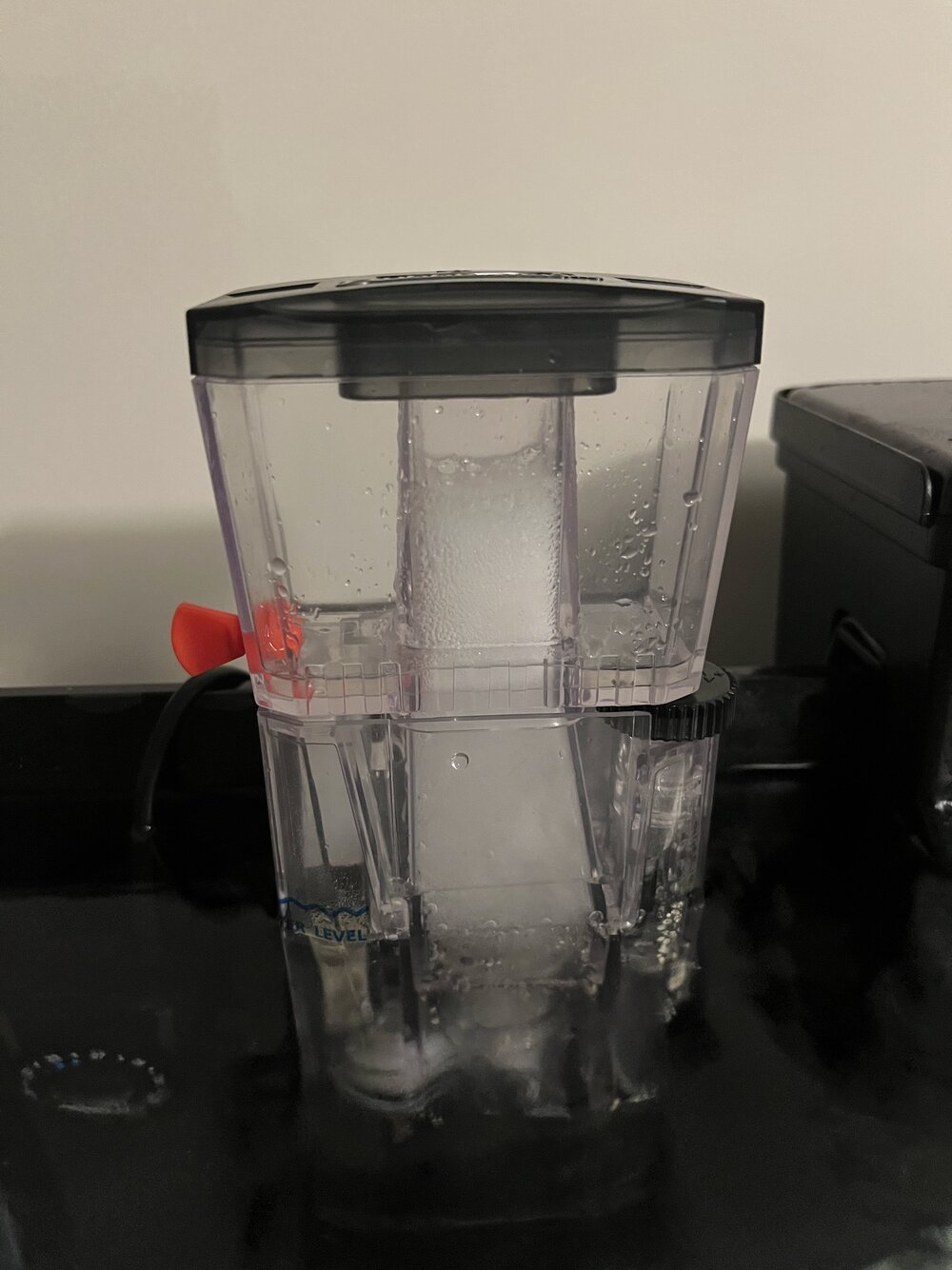
Skimmate this morning
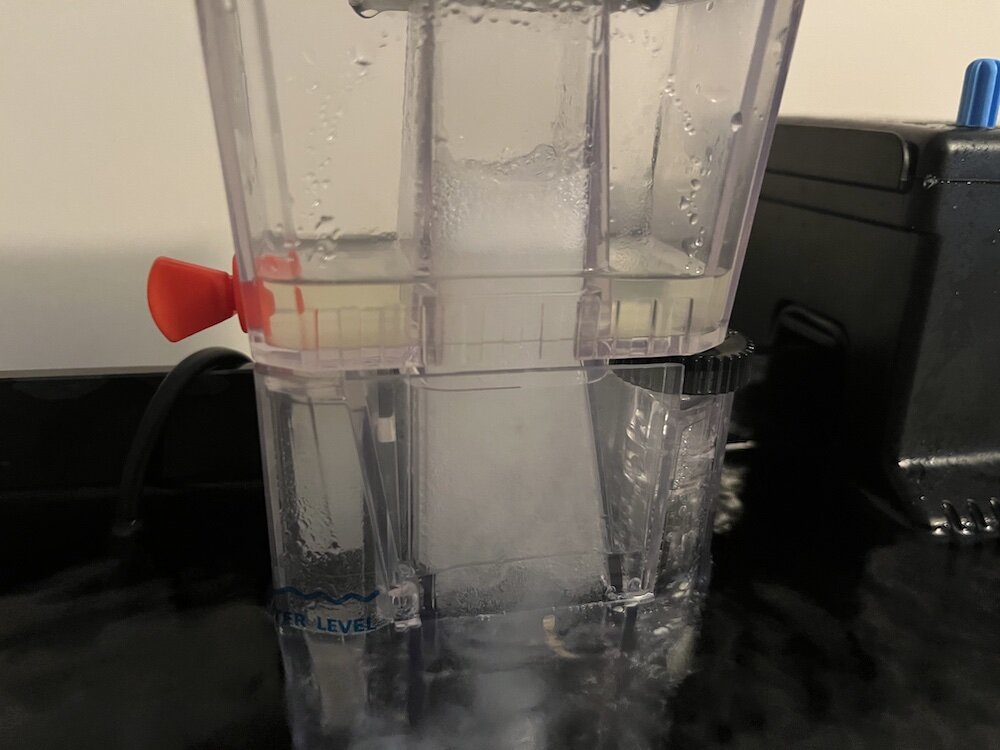
Latest readings:
Temp: 24.7 C
pH: 8 (Salifert)
Salinity: 1.025 SG (Refractometer)
Alkalinity: 8 dKH (Hanna)
Nitrate: 2.8 ppm (Hanna)
Phosphate: 0.1 ppm (Hanna)
Calcium: 375 ppm (Salifert)
The copepods and the phyto I ordered from an online shop never arrived. So I cancelled the order. I wonder how some businesses are still running.
Anyway, I received a new Hanna Calcium checker, an auto top up and a skimmer yesterday. Nothing fancy, a Kamoer ATO 2 and a Bubble Magus MiniQ. I installed the skimmer after a bath in citric acid.
The tank is quite new, so there's not much waste to skim.
Photo taken yesterday evening

Skimmate this morning

Last edited:
Latest test results after a 10% WC.
Temp: 24.6 C
pH: 8
Salinity: 1.026
Alkalinity: 7.7 dKH (Hanna)
Nitrate: Between 2 and 5 ppm (Salifert)
Phosphate: 0.11 ppm (Hanna)
Calcium: 394 ppm (Hanna)
Thoughts:
Calcium is increasing. That's good.
Phosphate stays the same, around 0.1. I have to set up the sump and the refugium with the macro algae to lower the nutrients.
Aiming to keep NO3 between 1 and 5 ppm and PO4 between 0.03 and 1 ppm.
Copepods will be added to the system tomorrow and I'll start dosing phytoplankton. Doing some research for an automatic system to culture and dose phyto.
Temp: 24.6 C
pH: 8
Salinity: 1.026
Alkalinity: 7.7 dKH (Hanna)
Nitrate: Between 2 and 5 ppm (Salifert)
Phosphate: 0.11 ppm (Hanna)
Calcium: 394 ppm (Hanna)
Thoughts:
Calcium is increasing. That's good.
Phosphate stays the same, around 0.1. I have to set up the sump and the refugium with the macro algae to lower the nutrients.
Aiming to keep NO3 between 1 and 5 ppm and PO4 between 0.03 and 1 ppm.
Copepods will be added to the system tomorrow and I'll start dosing phytoplankton. Doing some research for an automatic system to culture and dose phyto.
the1dogbikes
Member
I would of had fish an clean up crew in there with in 1 months but it looks like it's getting some were now
I've added 2 Mollies. It's too soon for CUC.I would of had fish an clean up crew in there with in 1 months but it looks like it's getting some were now
the1dogbikes
Member
I used to do it the real old fashioned way and use old sand out of someone else's tank an have fish in there with in the week lol . But really evert one does it there own way so keep doing what your doing an it has a lot less chance of going wrong.
The old fashioned way was using live rock, but that's not an option anymore.I used to do it the real old fashioned way and use old sand out of someone else's tank an have fish in there with in the week lol . But really evert one does it there own way so keep doing what your doing an it has a lot less chance of going wrong.
But I agree. There are so many different ways to run a reef tank. Some hobbyists add fish, CUC and corals from day one. Others wait for months before they add their first coral.
People follow different methods, usually according to their lifestyle. The important thing is to enjoy this hobby. All roads lead to Rome.


